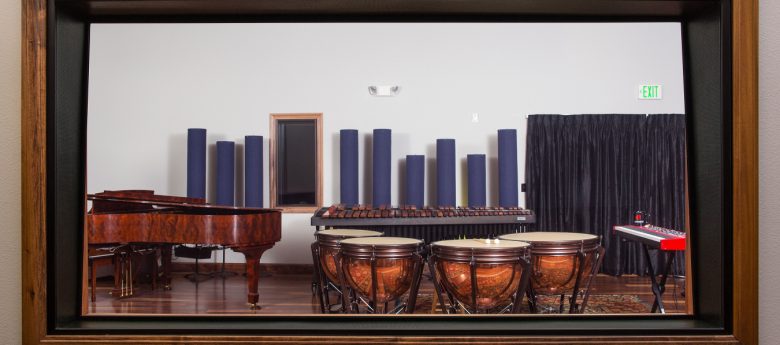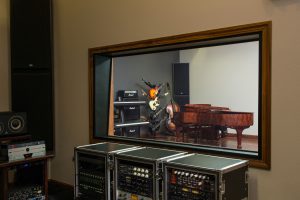Training for the Future with Broadcast Quality School Media Rooms
This article was featured on Facilitymanagement.com, written by Douglas Glenn Clark. (https://facilitymanagement.com/quality-school-media-rooms/)
Training for the Future with Broadcast Quality School Media Rooms

Now that STEM is STEAM, with the Arts added back into Science, Technology, Engineering, and Math, a growing number of school administrators are training students for the future by adding broadcast-quality school media rooms for those interested in radio and TV careers.
Yet insufficient planning on soundproofing school media rooms can make “on-air” broadcasts sound like a noisy school walkway or neighboring classroom after the bell rings. Clamor from busy streets, highways, railways, airports or even the school band can also intrude on school radio or TV programs.
To train students for professional broadcasting careers, one of the first orders of business is to help them sound professional on air, without unwanted noise pollution.
As a remedy, more school administrators are turning to recording studio techniques, to virtually eliminate noise from windows, one of the weakest links in allowing noise to enter broadcast media rooms. Since loud band practice can also distract students, these cost-effective techniques are also being used to soundproof school music rooms, libraries, and media centers to improve student attention and even test scores.
Recording Studio Techniques for Schools
To help students sound professional in school media rooms, a Reno, Nevada-based firm called Soundproof Windows, Inc. has applied techniques for recording studios – among the most noise sensitive environments in the world – to their products.
Since expansive window panes are essentially porous gateways to noise, the engineers developed an inner buffer (a second window) that can be used on existing old or new windows in a school building. The method controls noise but also temperature, which is important for preserving sensitive broadcast equipment.
The unique interior panels look just like the original windows no matter how old or new, or whether they are adjustable or permanently closed. This provides a lot of flexibility to school architects who may want to preserve historic vestiges of an old site while also modernizing it.
There are other reasons schools, hotels, businesses, and residences are utilizing the soundproof techniques: They can be used selectively. If there is no need for sound remediation in one wing of a complex, there is no need to make a change and incur the expense. Rather, focus on the areas of a school campus, such as media rooms, classrooms near the band room, libraries, and media centers, that are most damaged by background and external noise.
The Soundproof Windows products are often less expensive than competitors. But it is the testing process and specificity of the noise remediation plans that impress most school officials. For example, the company shares the type of materials used and their methods for sealing windows. They even explain the placement of screws to tamp down sound seepage. What works for recording artists can also work for school media rooms as well as the learning environment.

Improving Student Concentration and Test Scores
When planning for new school construction or renovation, administrators and architects consider a long list of needs and upgrades. Yet studies show that new features may do very little to address one of the most insidious enemies of learning: pervasive noise.
Learning in a noisy environment can be detrimental, especially for young students whose hearing is not yet fully developed. They do not comprehend the lesson if they cannot completely hear their teacher’s instruction. The same is true for students with attention deficit disorders, hereditary hearing problems and anyone for whom English is a second language. Studies show that children withdraw from classroom activities and fall behind in their work.
Noise from traffic, the band, choir, or neighboring classrooms may compete for a teacher’s attention.
For example, a pioneering study compared reading and auditory processing to levels of external noise in a home setting near an urban highway. Children who were tested had the same socio-economic background. But the student, whose apartment was far removed from the busy roadway, and therefore experienced less background noise, enjoyed higher reading scores.
In short, data reveal that poor classroom acoustics are barriers to learning, and reduce scholastic achievement.
Since improved schoolwork remains the goal of construction and renovation projects, better acoustical design is essential.
Avoid These Mistakes
A common misperception among school officials and others is that double-paned windows can reduce exterior noise. While that type of window may help control temperature, it lacks the acoustic sophistication needed to reduce noise.
Soundproof Windows, founded in 1998, does more than merely measure decibels on site. If necessary, their engineers will install test windows so that before-and-after noise levels can be compared. In some cases, the exterior noise drops 95 percent, according to managers of large properties that abut highways.
When choosing windows for a school project, look for a rating called Sound Transmission Class (STC.) The higher the number, the more noise is stopped. A typical rating for standard windows is 26 to 28. Yet the acoustic soundproof products used by most schools earn a 48 to 52 rating.
Also, buyer beware. Some manufacturers provide an STC rating only for the glass they use, not an installed unit. This can be deceptive because successful noise remediation is based on factors such as the air gap between the product and the existing window, the design of the frame and the installation.
Whether broadcasting radio or TV programs from the school media roomor studying for any STEAM subject, silence is golden. Therefore, new school construction and renovation experts offer suggestions.
First, locate “critical listening” environments and, when possible, keep them away from external noise sources. Meetings between facility managers and school administrators will help minimize noise intrusions by properly scheduling activities such as mowing lawns.
Finally, treat the school environment like a recording studio. Students training for careers in broadcast radio or TV, as well as all students on campus are capable of achieving great things with soundproof windows.
Douglas Glenn Clark honed his writing skills as an editor and reporter for daily newspapers, including The Los Angeles Daily News. He has provided stories for magazines, financial market groups and trade publications. He is also a direct-response marketing consultant and writer. For product information contact Soundproof Windows, Inc., at 4673 Aircenter Circle, Reno, NV 89502 or call 877.438.7843, email sales@soundproofwindows.com or visit www.soundproofwindows.com




